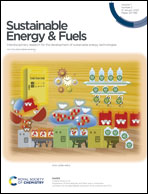Light transfer through bubble-filled electrolyte for solar water splitting†
Abstract
This study aims to systematically quantify the optical losses caused by hydrogen or oxygen bubbles released from an illuminated photoelectrode and rising through a semitransparent aqueous electrolyte during photoelectrochemical water splitting. Indeed, the presence of gas bubbles increases backscattering of the incident radiation and absorption losses in the electrolyte due to multiple scattering. These optical losses were quantified by predicting (i) the normal-hemispherical reflectance, (ii) the electrolyte absorptance, and (iii) the area-averaged absorptance of the photoelectrode for wavelengths between 400 and 1100 nm using the Monte Carlo ray-tracing method. Results are reported for randomly distributed monodisperse and polydisperse bubbles with diameter ranging between 100 μm and 1 mm, volume fraction varying between 0 and 30%, and plume thickness ranging from 2 to 20 mm. The photoelectrode absorptance and efficiency were found to decrease with decreasing bubble diameter and increasing bubble volume fraction and plume thickness. In fact, without careful design and operation, the optical losses can significantly degrade the photoelectrode performance. The contribution to the total optical losses from bubbles attached to the photoelectrode surface increased with increasing bubble contact surface area coverage and decreasing plume thickness. The results indicate that increasing the bubble departure diameter by increasing the surface tension of the electrolyte/bubble interface and flowing the electrolyte to reduce the plume thickness can substantially minimize the optical losses. Additionally, illuminating the PEC cell from the anode side could be particularly beneficial given the larger size and smaller volume fraction of oxygen bubbles as compared to hydrogen bubbles.



 Please wait while we load your content...
Please wait while we load your content...